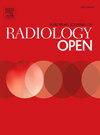Automatic measurement of Caton index on knee X-ray images using a key point detection model
IF 2.9
Q3 RADIOLOGY, NUCLEAR MEDICINE & MEDICAL IMAGING
引用次数: 0
Abstract
Purpose
To explore the feasibility of the You Only Look Once (YOLO) algorithm in the measurement of Carton index.
Methods
1156 knee X-ray images were collected from two centers (960 and 196). Five key points at patella and tibia on knee X-ray were labeled using the software of Labelme. YOLO11 pose models (including YOLO11n, YOLO11m and YOLO11x) were refined by labeled images from center A, and was then used to detect keypoints on images from center B. A line was the line between anterior edge of the tibial plateau and the lower pole of patellar articular surface, and B line was patellar articular surface. Carton index (A/B ratio) of 196 cases was obtained by senior radiologist, junior radiologist and YOLO respectively. The Bland Altman plot, Pearson Correlation test, Mean Absolute Error (MAE) and Intra-class correlation coefficient (ICC) were used to evaluate the agreement in measurement.
Results
Carton index of 196 images were automatically obtained with YOLO11n-pose, YOLO11m-pose and YOLO11x-pose. The ICC between senior and junior radiologists was 0.89. Pearson correlation coefficients were 0.23, 0.43 and 0.73 respectively for YOLO11n, YOLO11m and YOLO11x. ICC were 0.23, 0.42 and 0.72 respectively for YOLO11n, YOLO11m and YOLO11x. MAE were 0.20, 0.17 and 0.10 respectively for YOLO11n, YOLO11m and YOLO11x.
Conclusions
YOLO11x-pose model shows promise in the automatic measurement of Carton index on the knee X-ray image.
基于关键点检测模型的膝关节x线图像卡顿指数自动测量
目的探讨“You Only Look Once (YOLO)”算法在纸箱指标测量中的可行性。方法从两个中心(960和196)采集膝关节x线片1156张。采用Labelme软件标记膝关节x线髌骨和胫骨的5个关键点。通过A中心的标记图像对YOLO11位姿模型(包括YOLO11n、YOLO11m和YOLO11x)进行精细处理,然后检测B中心图像上的关键点。A线为胫骨平台前缘与髌骨关节面下极之间的直线,B线为髌骨关节面。196例患者分别由高级放射科医师、初级放射科医师和YOLO获得卡尔顿指数(A/B比)。采用Bland Altman图、Pearson相关检验、平均绝对误差(MAE)和类内相关系数(ICC)评价测量一致性。结果采用YOLO11n-pose、YOLO11m-pose和YOLO11x-pose自动获取196幅图像的卡尔顿指数。高级和初级放射科医师之间的ICC为0.89。YOLO11n、YOLO11m和YOLO11x的Pearson相关系数分别为0.23、0.43和0.73。YOLO11n、YOLO11m和YOLO11x的ICC分别为0.23、0.42和0.72。YOLO11n、YOLO11m和YOLO11x的MAE分别为0.20、0.17和0.10。结论syolo11x -pose模型在膝关节x线图像的卡尔顿指数自动测量中具有较好的应用前景。
本文章由计算机程序翻译,如有差异,请以英文原文为准。
求助全文
约1分钟内获得全文
求助全文
来源期刊

European Journal of Radiology Open
Medicine-Radiology, Nuclear Medicine and Imaging
CiteScore
4.10
自引率
5.00%
发文量
55
审稿时长
51 days
 求助内容:
求助内容: 应助结果提醒方式:
应助结果提醒方式:


